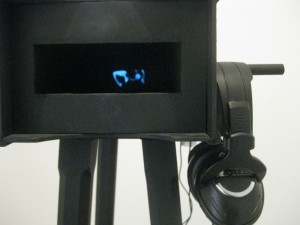Peeping through holes at ladies dancing is not the main prospect which comes to mind when you plan a gallery visit. And to see Remahl’s work, men will have to stoop.
But your sense of decorum is just about preserved when you realise that this peephole only features some arty, black and white, jump cut choreography: fully clothed.
The headphones are a lot more comfortable (and fill your head with some reassuring gypsy folk rather than, thankfully, a wakka chikka porno groove).
Mien is a response to the poetry of Galician writer Xelis de Toro, whose book in translation, Invisible Bridges, has inspired an entire exhibition here in Brighton.
So Remahl’s work reminds us that good writing may be seen as dancing with the pen. And the pen is surely not merely a pen, anymore than a cigar is just a cigar.
But the apparent frivolity of dance is a stumbling block for serious poetry or prose, like the stance of anarchist Emma Goldman: “If I can’t dance, I don’t want to be part of your revolution.â€
And what if there is an element of sleaze about all dance, ergo about all writing? That might explain why the famous 1913 performance of Rites of Spring degenerated into a riot.
No one likes to be confronted with their voyeurism, least of all the grand bourgeois of pre-War Paris. They would recognise Remahl’s work for what it is, a gentle scandal of sorts.
The Book of Invisible Bridges can be seen at Phoenix, Brighton, until August 14 2012. See gallery website for opening times, directions and full programme of supporting activity.

No Comments